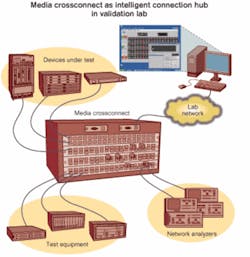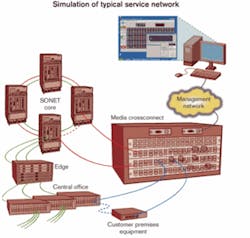Media crossconnects aid network simulation, test
The task of testing SONET, Ethernet, Fibre Channel, and FireWire networks is becoming more complex as the number of network users grows and the size and sophistication of switching and routing devices increase. In the face of this growing complexity, it is critical that a network react both quickly and predictably to change, both logical and physical; therefore, the ability to test network equipment for these features is critical as well.
One area of testing that can benefit from greater control and automation is the management of physical network connections. The ability to automatically alter network connections, network topology, simulated fiber cuts, and cable connects and disconnects results in the more efficient use of testing resources and increased productivity.
An examination of the network infrastructure common in many labs shows that relying on the manual configuration of test networks adversely affects the process of validation, development, and deployment. As an alternative to such manual methods, the media crossconnect is an important tool for managing and automating the configuration of test networks.
Today’s test lab is outfitted with more sophisticated hardware and software than ever before, all of which is designed to help test engineers perform their job more effectively and efficiently. And while powerful automation tools exist to facilitate the logical configuration of this equipment, more can be done to automate the configuration of the physical connections that network all these devices together. There are a number of shortcomings in labs where the configuration is done manually:
• No lights-out testing. Even test engineers require sleep. Sure, they can start a test before they leave. But if there is no one physically there to manually change connections, the test can only comprise one static configuration, thereby severely limiting its scope. And even once that test has been completed, no other test can be run until someone returns to the lab.
• More effort spent on labmanagement. Ever watched an engineer struggling to unravel a tangled mess of cables or ever seen snapshots of different wiring configurations taped to an equipment rack? The constant swapping of cables leads to either chaos or more management effort. Either way, valuable time is spent managing the lab instead of on actual testing.
• More chances for error. No matter how careful we are, sooner or later we all make a mistake. In the case of test labs, the more frequently cables are moved around, the greater the chances that a problem will arise (e.g., a wrong connection is made, a cable is damaged, or a fiber-optic component is contaminated with dirt).
• “Test sitting.” It is often critical to investigate and understand what happens when a physical network connection is lost, such as when a fiber is cut. Yet in more than a few labs, the method for conducting this type of test is to have someone sit in front of a device under test (DUT) or patch panel and wait for the right moment to unplug a connection-a task that’s probably not the best use of their time.
• Inefficient use of lab resources. It’s never good when people are waiting to use equipment or, worse, to have equipment sitting around unused. Unfortunately, when connections between DUTs and test equipment must always be manually configured, the possibility of these inefficiencies arising is very real. The options in a manual environment to combat these issues would be to schedule access to the lab resources-an idea sure to raise conflicts-or over-provision the amount of resources available to meet peak demand and thus leave a lot of very expensive equipment sitting unused a good deal of the time.
• Longer testing periods and development cycles, delayed deployments, and overall higher costs. Ultimately, all of the above factors adversely affect the bottom line however it is measured, because testing affects every metric of success: product quality, customer satisfaction, development time, etc. Yet, so many test labs today are not operating at the highest levels possible simply because engineers and technicians must manually configure every test setup.
Faced with this knowledge, the question becomes how to better manage the network connections in a test lab and automate their configuration. What’s needed is an intelligent patch panel that can connect any protocol or physical media and will allow those connections to be altered-added, dropped or reassigned-at any time without the need for physically plugging or unplugging any cable. Fortunately, such a device already exists.
A media crossconnect (MXC) is a multiport, multiprotocol device with a digital backplane that can be programmed to provide connectivity from any port to any other port on demand. It makes adding, dropping, or altering network connections at will possible without physical rewiring.
Flexibility with control is the goal of the MXC. It incorporates a number of features that help achieve this goal:
• Any-port-to-any-port programmable connectivity. That is the heart of what an MXC is and does and why it can be an invaluable asset for network testing. Once test equipment, network devices, and DUTs have been plugged into an MXC, there is no need to physically move cables when a connection change is required. Device A can be connected to device B one moment, then to device C the next using commands entered through a management interface or through an automated script. In MXCs with port-to-multiport capabilities, it’s possible to have device A transmit simultaneously to devices B and C, in which device C could be a network analyzer, for example.
• Wide range of supported protocols per connection. As protocol-transparent devices operating at the physical network layer, MXCs can support a wide range of data rates, some systems as wide as 0-5 Gbits/sec, covering everything from T1/E1 all the way to 4-Gbit/sec Fibre Channel and above. Support for 10 Gbits/sec should be available by the press time. The design of the typical MXC also makes it possible to handle different protocols within the same chassis. Each connection can operate independently; the data signals can be handled with either 2R signal conditioning or 3R signal regeneration.
• Pluggable transceiver support. If you a wide range of protocols is supported, then a wide range of media types must also be supported. To address this issue, MXCs are engineered to use pluggable transceivers, notably SFPs and XFPs, with some systems also supporting Digital Diagnostics (SFF-8472) management. Pluggable transceivers offer nearly limitless connection flexibility. Today, for instance, SFPs are available for virtually any protocol from Ethernet to SONET to Fibre Channel and any type of interface, including multimode, singlemode, single fiber, CWDM, and DWDM fiber-optic interfaces as well as 10/100/1000Base-TX (RJ-45), SDI/DVB (coaxial-cable), and FireWire (IEEE-1394a/b) copper interfaces.
• High-density form factor. With each generation of MXCs, the number of connections that can be managed within a single system grows. There are media crossconnects available that support 144 ports in just five units of rack space. Within the first half of this year, systems capable of supporting upwards of 288 connections will appear.
• Operational transparency. Signal integrity and low latency are key to the success of network simulation. Accordingly, a media crossconnect designed for the rigors of testing should have negligible effect on any data signal so as not to affect the outcome of a test. In essence, their operation should remain transparent.
• System management and automation capabilities. Greater flexibility demands greater control. The areas of system management and automation therefore are critical in any media crossconnect. The best systems provide extensive scripting capabilities both natively and through third-party test automation tools, thus enabling full control over the timing and order of any network connection changes. Some MXCs also offer Linux-based operating environments that incorporate advanced management features such as SNMP v3 for enhanced remote management, secure socket shell, and enhanced multi-user support where a group of ports can be assigned to a specific user.
The power and flexibility of an MXC make it suitable for an extremely wide range of applications. The same device can be used for network staging and simulation, the validation of new products, and as the central connection point for dynamic networks. R&D, validation, production, training, customer support, and interoperability labs can all benefit from the use of a media crossconnect.
Figure 1 shows a typical validation-lab setup. The MXC sits in the logical center of the lab network, where it controls the connections between all devices. In this position the system can also be set to monitor or “tap into” the data signal from any node. For example, the test equipment sends test data to the DUT. As the DUT responds, the return data is not only transmitted back to the test equipment but is also duplicated and sent in real time to a network analyzer. This ability can make for a powerful tool in quickly debugging problems.Such simulations enable proper network planning and evaluation before full-scale deployment. The MXC makes it possible to fully control how and when the events occur and to duplicate the test as needed. Such rigorous testing goes a long way in preventing problems from occurring after deployment, when they can result in a huge expense in truck rolls, technician time, and customer downtime.
MXCs simplify lab management by taking the process of changing network connections by hand and turning it into a process of logical reassignment whereby network configurations can be stored electronically and recalled as needed. By extension, the chances of inducing configuration errors are reduced, and the consistency and repeatability of a given test are improved.
Through the automated scripting capabilities of an MXC, more efficient use is made of lab equipment and a test engineer’s time is made more productive. When no one is needed to manually alter network connections during or between tests, it becomes possible to queue a series of tests, resulting in true lights-out testing. Use of available time and existing resources is maximized.
Ultimately, the justification for an MXC, just as with any other resource, is the return on investment it provides. In this context, the total impact an MXC has on the bottom line is nearly immeasurable. The benefits of faster, more complete, and more predictable test execution ripple throughout the entire testing, development, and deployment process. And in as much as improved testing leads to improved user satisfaction, the media crossconnect has an impact on that bottom line as well.Eli Lauferis general manager andTroy Larsenis technical marketing manager at MRV Communications (Chatsworth, CA).


